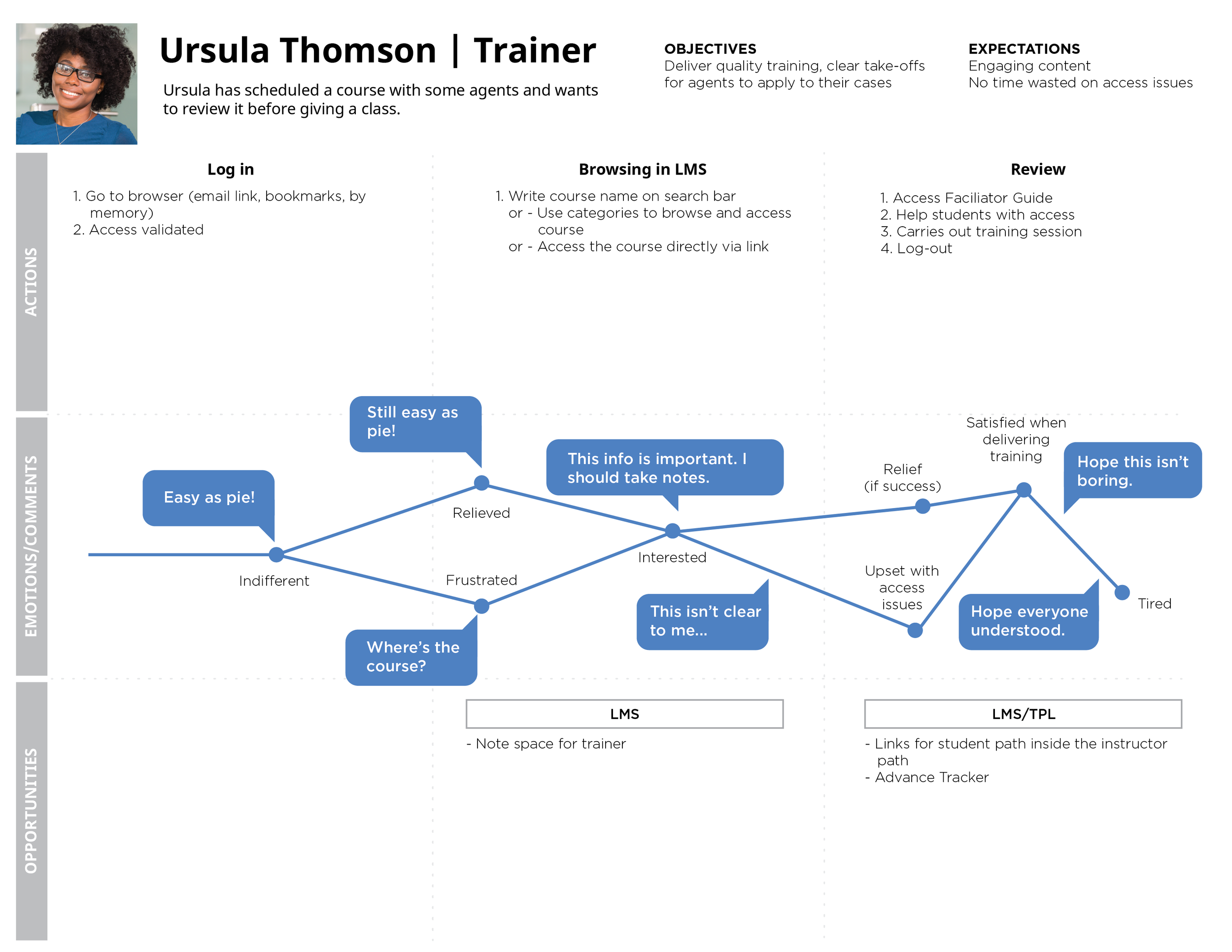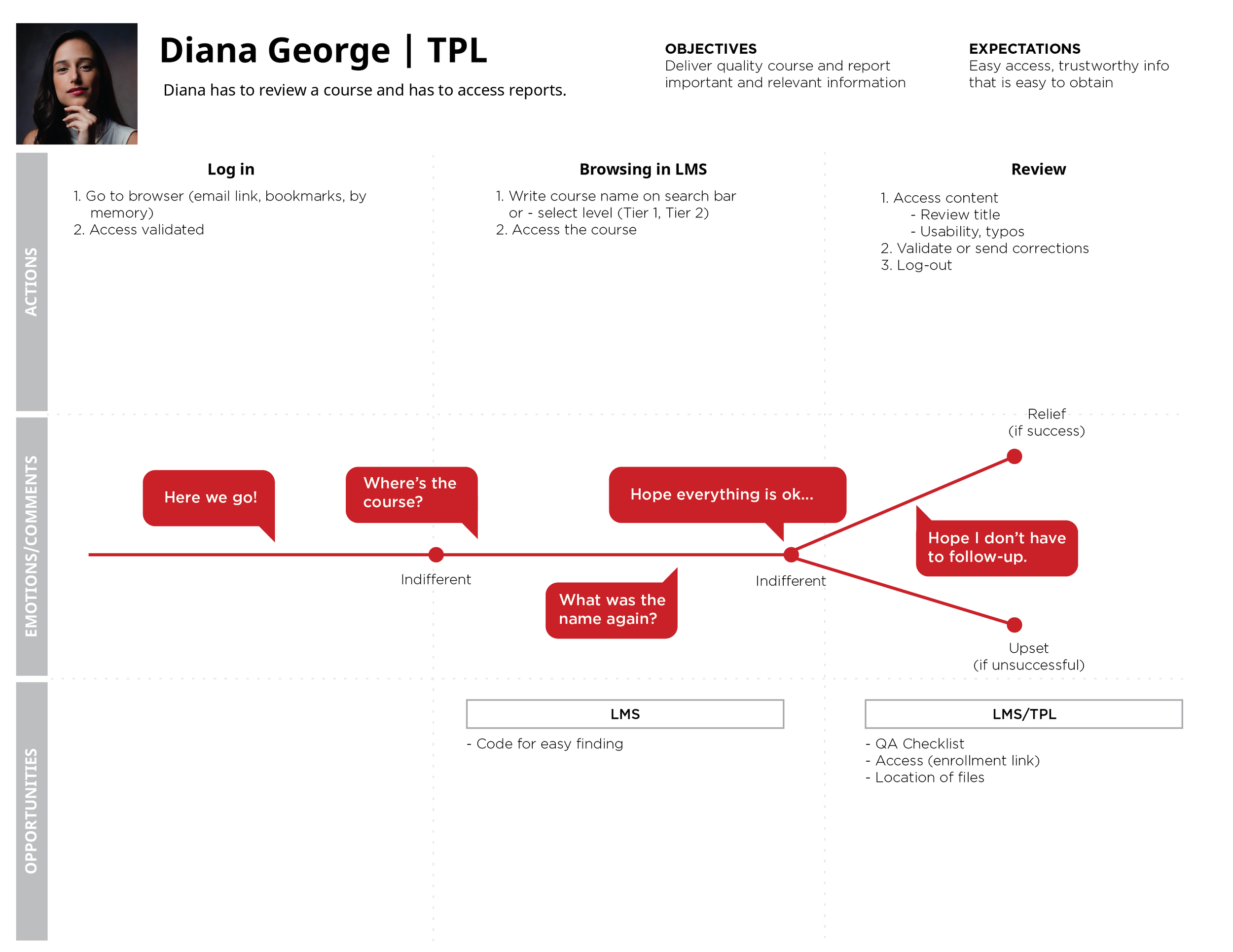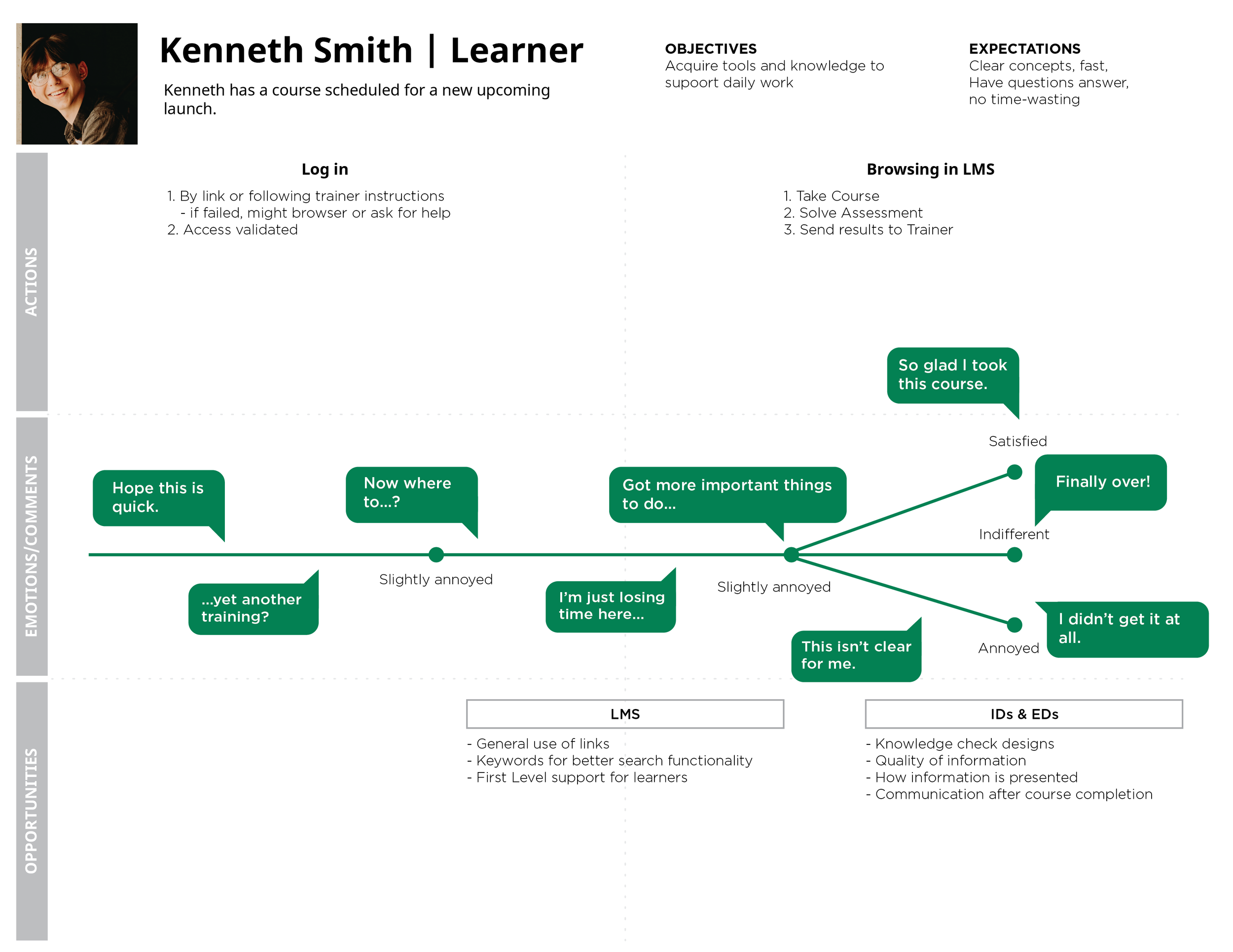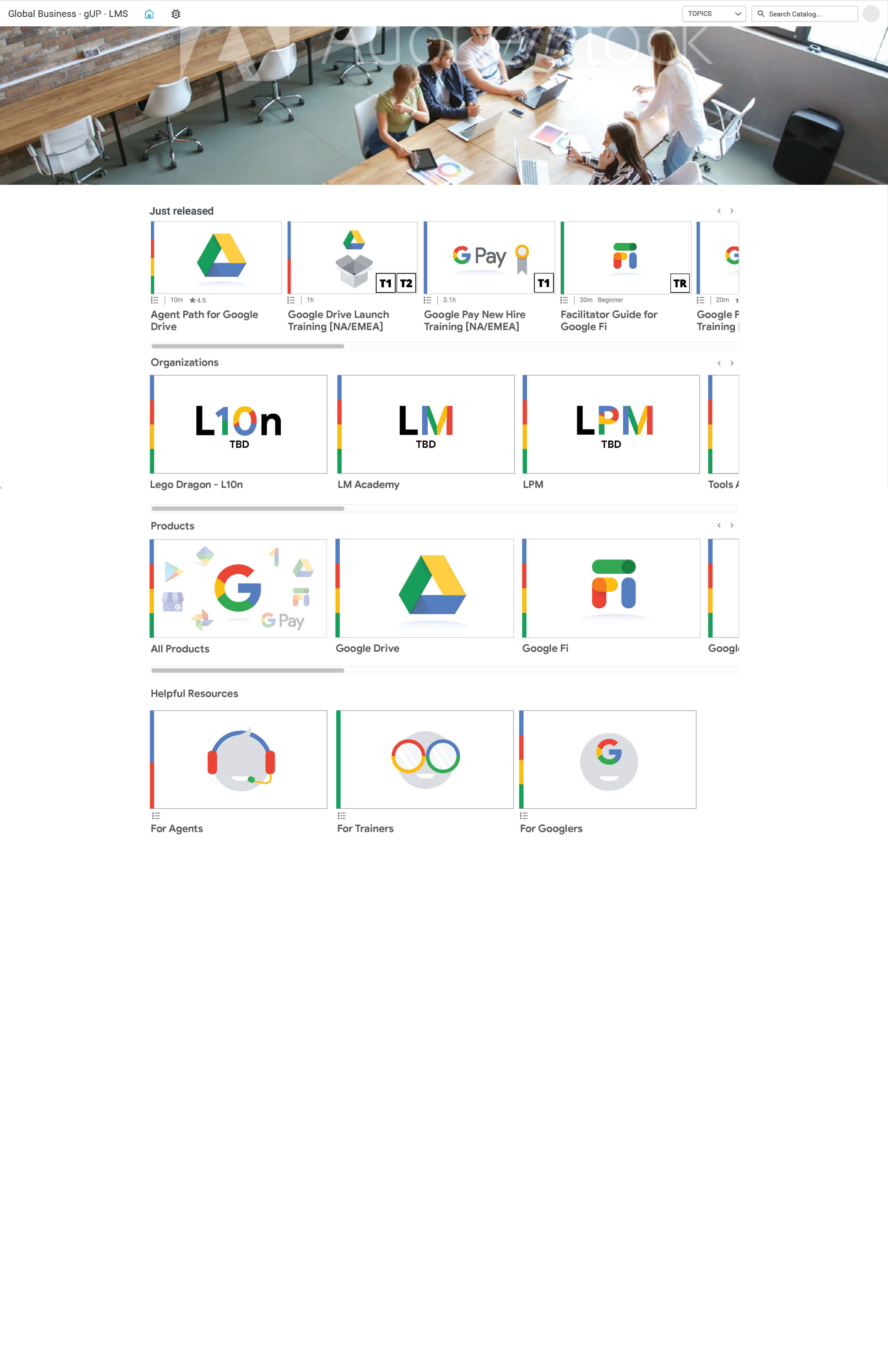Introduction
This project was a business consultation effort for Google. The client came to my team and asked us to help restructure their LMS system to make it easier for their learners to navigate and find courses.
Tools:
Illustrator
Photoshop
InDesign
Evolve/Intellum
Team:
Sopary - UI/UX Designer, Art Direction
Aaron - Lead LMS Admin, Developer
Sergio - LMS Admin, Developer
Emily - Project Lead
The Goal:
Help learners and trainers find the courses they need for just-in-time training in an easy to navigate LMS environment
This project was broken down into two phases. The first phase was to reorganize the structure of the LMS to make navigation easier for users. The second phase was to do a graphical overall of imagery for the LMS.
PHASE 1
User Research
To learn more about users and what they need, we had two interview sessions with different tiers of individuals. From these interview sessions, we created three personas to represent each tier that interact with the LMS: Training Production Lead, Trainer, and Learner. The LMS team led this portion of the process. I was there to help synthesize their findings in a presentable format for presentations to stakeholders.
Personas
Trainer:
Urusla Thomson
Demographics
Age: 35
Moderate Tech Proficiency
Married
20% of LMS User Population
Goals
Deliver good training with tools on hand
Have my work transform into rewards that benefit my day-to-day
To deliver training no matter the conditions, or location
-
Have an impact on other peopleʼs lives
Make a difference
-
Are the people really learning?
Are they bored?
Is the information useful?
Training Production Lead:
Diana George
Demographics
Age: 28
High Tech Proficiency
Married
10% of LMS User Population
Goals:
Professional growth
Deliver fast solutions to problems
-
Home office
Fast responses
Good info - short time
Deliver quality results
-
Unclear information
Extremely long processes
So many emails, so little time
Learner:
Kenneth Smith
Demographics:
Age: 22
High Tech Proficiency
Single, Dating
70% of LMS User Population
Goals:
Donʼt let work absorb my entire life
Manage the time I have and enjoy life
Will do my best if the tools are provided
-
Quick and effective actions
Tech consumer
Trying new solutions
Learning new technologies
-
Wasting time
Slowness
Lack of clarity
User Journeys
From these user interviews, I helped the team develop user journeys for each persona. Please click through the journeys below to see how each traverses through the LMS.



Insights
From these journeys, the LMS team was able to extrapolate key pain points and areas to improve on. Click through these accordions below to learn more.
TPL
-
QA
“What are the reporting capabilities of the LMS?”
LMS/course errors that end up in their email
-
QA checklist for easy review
Dashboards
Description of the reportable data in the LMS
Trainer
-
Search content when needed
Tracking learners progress
Make sure learners learn
Engagement
-
Link between trainer and learner paths
New approach in designing knowledge checks
Keywords for finding content
Resources to be the first level support for learners
Learner
-
Engagement
Concepts and names in courses donʼt match with their day-to-day
Confusion with activities titles and names
Time vs gain
-
Communications
Keywords for finding courses without links
Support
New approach in designing knowledge checks
Proposed Restructure of LMS
After completing the analysis of the users and their pain points with using the existing learning environment, we dug deep into how the LMS was structured. From this thorough digging we noticed some inconsistencies with the learning modules/paths.
Old Structure:
The old structure has a lot of disjointed learning paths that makes sudden jumps to different sections creating an unexpected experience for the learner. This disjointed pattern also makes it difficult for the LMS Team to track completion metrics.
New Proposed Structure:
The new proposed structure makes it so that each path is associated with a course and activity thus creating a normalized and expected experience for the learner. This also makes it so that a “path” can be used to mark a start for a course and an “activity” can be marked as the endpoint, making it easier to track learning completion rates.
Restructuring Begins
With these findings, we presented to the client how we intended to make the LMS easier to navigate for all parties involve. Thus began the long work of reorganizing all the courses and modules into the proposed structure.
Phase 2
Creating a Design Ecosystem
With Phase 1 and the restructuring of the LMS in the hands of the LMS team, I began working on devising a strategy to visually show users at a glance what icons and symbols pertain to the user.
The team at Google wanted clear indication between New Hire Training and Launches as well as a way to indicate learning paths for users.
They also wanted defined imagery for the tier level of content.
Trainers had their own separate icon so they would know which content was specific to them. This “trainer content” would also be turned off for the learners that are not trainers.
As you click through the slide show, you can see how all these separate elements are combined to visually build a system for users to know which training is for which tier of learner.
Click through the gallery to view the system
Hi Fidelity Screens
With the system designed, I began building out pages for the multitude of products that learners will have to support. I decided to go with a photo banner to help agents associate that they are learning to provide solutions for real users and customers.
Please click through to see the HI-FI Screens
Implementing Client Feedback & Pivoting
Although the client liked the direction of the ecosystem developed for the LMS, they had already developed an initial style for the imagery. They did carry over the ideas of marking the thumbnails with varying annotations so viewers can see at a glance which module is for which learner. My task then shifted to providing art direction and project management (i.e. planning out with Google’s Multimedia team what assets were needed and deliverable timelines).
Lessons Learned
Through this project, I learned how each part of a team worked together to create a user/learner experience that is more easier to access and flow through no matter what role they had. The experience has helped me sharpen my research skills, information architecture skills, and gave me the opportunity to design a visual system.





















